- Culture & Heritage:
- Palembang
As the capital city of South Sumatra, Palembang is the center of governance as well as trade and tourism, and this has been going on since the era of the Sriwijaya Kingdom, a once powerful Malay Kingdom that thrived at the banks of the Musi River that separates the city into two areas, Seberang Ilir to the north and Seberang Ulu to the south.
 |
| Ampera Bridge |
There are a few things you can do here. First, you can go see the Ampera Bridge, the country's largest bridge and Palembang's icon that stretches across Musi River. It was built in 1962 after getting the approval from Indonesia's first president Soekarno and was originally named after him, but as then changed due to the anti-Soekarno movement. The bridge used to open up when ships passed by the river, but no longer operates that way. If you are visiting during Indonesia's Independence Day, then you can see festivals here such as the Bidar boat race, a boat race that involves around twenty people per boat or you can also see boat decoration contest.
 |
| Benteng Kuto Besak |
Not far from the bridge, there is another relic of the past, Benteng Kuto Besak, a fort that was built by the Palembang Sultanate in 1797 to defend the city against the Dutch's attacks. Standing at 289 meters in length and 184 meters in width, encircled by a ten-meter wall as thick as 2 meters, the Dutch's corvettes didn't stand a chance against it. It is situated next to the river and at the view here at night is pretty amazing as the river reflects the yellow lights. Make sure you visit it.
Don't forget to visit Masjid Agung (Grand Mosque). It was built in 1748 during the Palembang Darussalam Sultanate. With a capacity of 9,000 visitors, this mosque was once the biggest mosque in the country. Its architecture is very interesting, since its main building is Chinese in style and its main entrance is Greek. Arabic calligraphies also are an element of its beauty. A worth-seeing tourist spot when you are in Palembang.
 |
| Masjid Agung |
If you are hungry, you can go taste the local dishes at restaurants beside the river or even at the floating restaurants. Here you can taste Pindang Ikan Patin, a local specialty made from catfish.
- Culture & Heritage, Eco-tourism:
- Pagaralam
Pagaralam is located on the west coast of Sumatra Island at the base of Mount Dempo, west of Palembang. It has a potential for tourism because of a number of waterfalls as its natural beauty and megalithic relics that hold important historical value.
Here you can see the Lematang Waterfall, one of Pagaralam's beautiful spots. It is surrounded by green trees and rocks at the bottom, which make this waterfall a great tourist destination. It is viewable from the from the road above, in fact many people who pass the road often stop to admire its beauty. Or if you want to enjoy the splashes you can go down the stairs, but be careful because it is very steep. You will only need to pay an entrance fee around 1,000 rupiah. If you want to take a rest, there are small street vendors and food stalls on the roadside.
 |
| Lematang Waterfall |
Go to nearby villages to take a look at megalithic structures that was used by the ancient society. You can visit Tegurwangi village to see menhir, a tall stone that was used to honor the dead, as well as statues and stone coffins.
 |
| Megalith |





























